Overview
This article highlights the critical importance of recognizing the early signs of type 2 diabetes. Symptoms such as increased thirst, frequent urination, unexplained weight loss, blurred vision, fatigue, slow-healing sores, frequent infections, and dark skin patches are essential to be aware of. It's understandable to feel overwhelmed by this information, but early detection and prompt medical intervention can significantly improve your health outcomes and management strategies.
Statistics and real-life examples underscore the severe consequences of uncontrolled diabetes, reinforcing the need for vigilance. Remember, you're not alone in this journey; many have faced similar challenges and found ways to manage their health effectively. We are here to support you every step of the way.
If you notice any of these symptoms, please consider reaching out to a healthcare professional for guidance. Taking action now can lead to a healthier future, filled with hope and support.
Introduction
In a world where health challenges are increasingly prevalent, understanding the early signs of Type 2 Diabetes is crucial for effective management and prevention. You’re not alone in this journey; T2DSolutions emerges as a vital resource, dedicated to empowering individuals with the knowledge they need to recognize symptoms such as:
- Increased thirst
- Frequent urination
- Unexplained weight loss
This platform not only offers educational materials but also fosters a supportive community, encouraging proactive health management. With research indicating that early detection can significantly improve health outcomes, we are here to support you every step of the way. T2DSolutions serves as a beacon of hope, guiding individuals toward timely medical intervention and a better quality of life.
T2DSolutions: Essential Resource for Recognizing Early Type 2 Diabetes Signs
At T2DSolutions, we are dedicated to empowering individuals with the knowledge they need to identify the signs of type 2 diabetes. As a new resource center for blood sugar management, we offer a wealth of educational materials, including informative articles and community support. Our goal is to enable you to recognize type 2 diabetes signs swiftly, which is essential for facilitating prompt medical intervention and improving your health outcomes.
We emphasize clear, actionable information, making it easy for you to understand and implement the knowledge you acquire, especially when it comes to recognizing early type 2 diabetes signs, which is vital. Studies indicate that early detection can significantly enhance management strategies and reduce the risk of complications. For instance, did you know that around 73,000 lower-limb amputations were conducted in diabetics aged 20 and older? This highlights the severe repercussions of uncontrolled blood sugar.
Regular monitoring of health indicators, such as blood sugar levels, cholesterol, and blood pressure, is essential for mitigating diabetes-related risks. Furthermore, individuals with diabetes are notably at a higher risk of experiencing mental health challenges, being twice as likely to suffer from depression compared to those without it. This emphasizes the importance of early identification and intervention in managing both the physical and mental health aspects of the condition, especially concerning type 2 diabetes signs.
At T2DSolutions, we showcase effective education programs that concentrate on early recognition of type 2 diabetes signs, stressing the necessity of proactive health management. By fostering a supportive community, we encourage you to share your experiences and learn from one another, reinforcing the collective journey of managing diabetes. Additionally, our platform includes a visual guide for snacks, as mentioned by Katherine Marengo, R.D., which can assist in removing the uncertainty from dietary decisions when managing Type 2.
This holistic approach not only aids in early detection but also promotes a better quality of life for those affected. For additional details, we invite you to consult the 11th Edition of the IDF Atlas, a reliable source for managing the condition. By providing a wealth of resources, practical tips, and expert insights, T2DSolutions enhances diabetes management and empowers you to make informed decisions about your health. Remember, you're not alone in this journey; we are here to support you every step of the way.
Increased Thirst: A Common Early Warning Sign of Type 2 Diabetes
Heightened thirst, clinically known as polydipsia, is often one of the first type 2 diabetes signs. This symptom occurs when elevated blood sugar levels lead to dehydration, prompting the body's thirst response. Research from the SHIELD study reveals that nearly 50% of newly diagnosed patients report experiencing polydipsia, highlighting its importance as a potential indicator of type 2 diabetes signs. It's crucial for medical professionals to recognize this symptom, as it frequently accompanies other type 2 diabetes signs such as frequent urination and fatigue. For instance, the SHIELD study found that individuals with polydipsia were more likely to receive a Type 2 Diabetes diagnosis within a year.
Real-life experiences illustrate the impact of polydipsia on daily living. Patients, like Randy Jackson, have shared their journeys of increased fluid intake, often leading them to seek medical advice, which ultimately resulted in timely diagnoses and effective management plans. Jackson noted that living with diabetes involves learning many surprising aspects, such as managing thirst and hydration.
Experts agree that recognizing heightened thirst as a symptom is essential for prompt intervention. Health professionals emphasize that addressing polydipsia can significantly enhance patient outcomes by facilitating early diagnosis and treatment. Dr. Shamard Charles, MD, MPH, highlights the urgency of identifying such symptoms, noting that over one million individuals perish annually from Type 2 diabetes mellitus, making it the ninth leading cause of death globally.
Moreover, recent research indicates that effectively managing blood sugar levels can alleviate symptoms of polydipsia. Dietary strategies, such as adopting a Mediterranean or plant-based diet, have been linked to improved hydration and reduced thirst, underscoring the importance of comprehensive diabetes management. A case study on dietary management emphasizes that effective strategies include:
- Understanding portion control
- Avoiding added sugars
- Focusing on high-fiber foods
In summary, if you find yourself drinking more than usual, especially alongside other symptoms, it’s vital to consult a healthcare provider. Identifying polydipsia as one of the type 2 diabetes signs can lead to proactive health measures and improved management of your condition. Remember, you're not alone in this journey; we are here to support you every step of the way.
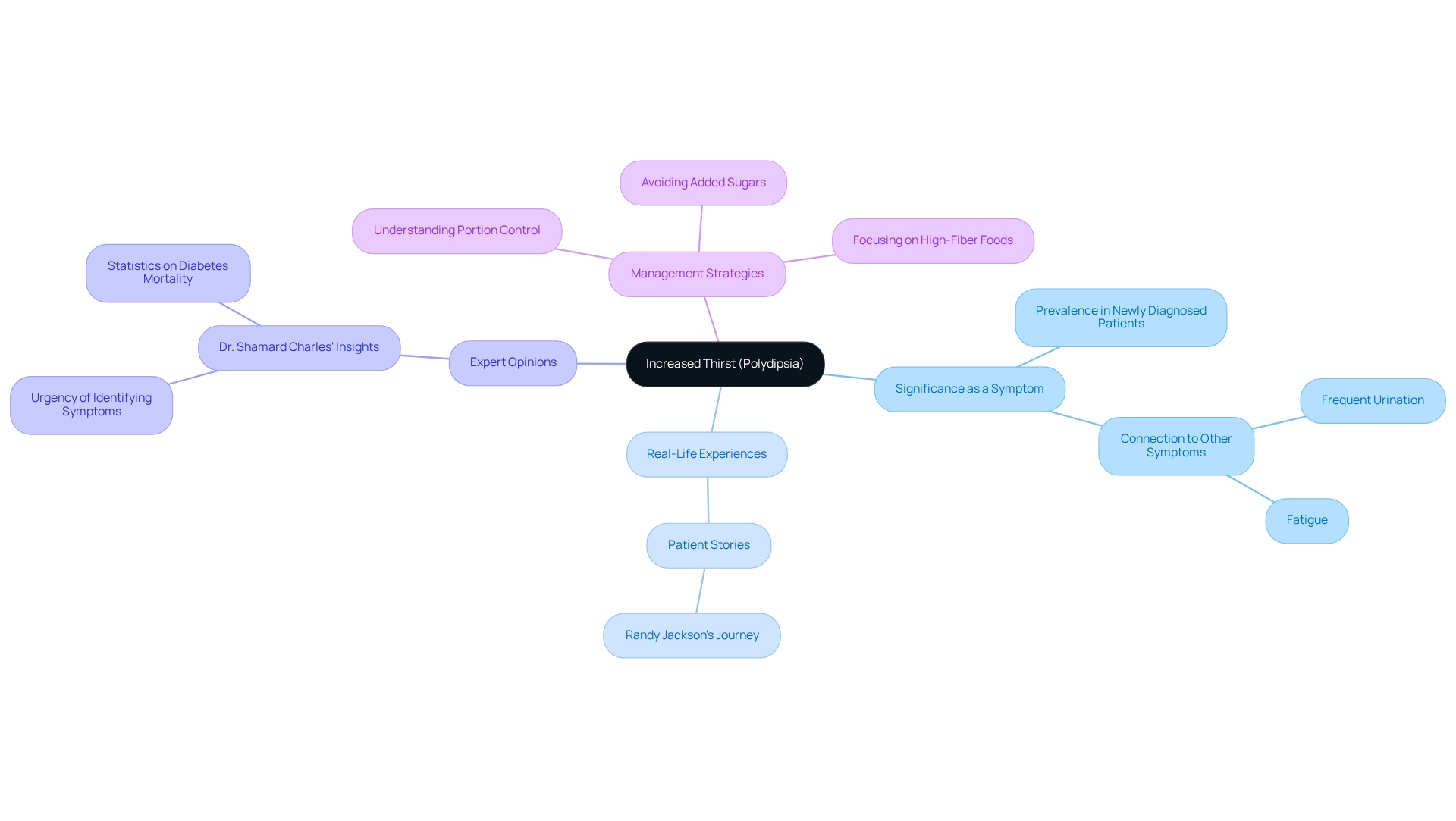
Frequent Urination: Key Indicator of Potential Type 2 Diabetes
Frequent urination, known in medical terms as polyuria, serves as an important warning sign for potential type 2 diabetes signs related to blood sugar issues. When blood sugar levels rise, the kidneys work harder to filter and eliminate the excess glucose, leading to increased urine production. This condition often results in a noticeable increase in urination frequency, especially at night, which can disrupt sleep and lead to further health complications.
Recent findings reveal that polyuria is common among newly diagnosed Type 2 diabetes patients, with studies indicating that about 30% of individuals report this symptom at diagnosis. This statistic highlights the importance of recognizing frequent urination as a potential indicator of a metabolic disorder. Healthcare specialists emphasize that persistent polyuria is among the type 2 diabetes signs that, particularly when accompanied by additional symptoms such as fatigue, blurred vision, and slow-healing wounds, warrants immediate medical evaluation. Personal stories from individuals navigating blood sugar challenges illustrate the journey from experiencing polyuria to receiving a diagnosis. These narratives not only create a sense of community but also inspire others to seek help when they encounter similar symptoms. The case study titled 'Inspiring Personal Stories' showcases how shared experiences can cultivate a supportive environment for those managing their health.
Understanding how high blood sugar affects kidney function is crucial, as prolonged elevated glucose levels can lead to kidney damage over time, complicating health management further. Additionally, being part of a high-risk ethnic community is a recognized risk factor for Type 2 diabetes, emphasizing the importance of being vigilant about type 2 diabetes signs such as polyuria. In the context of a comprehensive strategy for diabetes awareness, it's vital to stay informed about the type 2 diabetes signs and symptoms, including polyuria. Engaging with healthcare professionals for screening and guidance, as recommended by the Canadian Task Force on Preventive Health Care, can significantly influence timely diagnosis and effective management of blood sugar issues. Moreover, T2DSolutions offers valuable resources and community support for individuals experiencing these symptoms, encouraging them to seek assistance and remain informed about their health.

Unexplained Weight Loss: A Critical Early Sign of Type 2 Diabetes
Unexplained weight loss serves as a crucial initial warning signal for the second form of diabetes. When the body struggles to utilize glucose effectively due to insulin resistance, it compensates by breaking down fat and muscle for energy, leading to unintended weight loss. This situation is particularly concerning, as studies indicate that while unexplained weight loss is more frequently associated with the first type, it can also occur in patients with the second type. If you notice significant weight loss without any intentional changes to your diet or exercise routine, it's vital to consult a healthcare professional promptly.
Recent research underscores the common occurrence of weight loss as one of the type 2 diabetes signs. Experts emphasize the importance of regularly monitoring blood sugar levels, cholesterol, and blood pressure to reduce the risk of this condition. Additionally, the emotional impact of the illness is significant; individuals with Type 2 Diabetes are twice as likely to experience depression compared to those without it. This highlights the importance of addressing both physical and mental health aspects in managing the condition. Recognizing the mental health challenges associated with this illness, T2DSolutions integrates mental health support into its resources, reinforcing a holistic approach to care.
Real-life examples illustrate how unexplained weight loss can lead to a diabetes diagnosis, reinforcing the need for awareness and proactive health measures. As Tiffany Danczak wisely states, "Don’t let yourself fall; you gotta pick yourself right up and strive to do better and be better!" By promptly identifying type 2 diabetes signs, individuals can take significant steps toward effective management and improved health outcomes. If you experience unexplained weight loss, prioritize consulting with a healthcare professional to explore your options and ensure comprehensive care. For additional support and resources, consider visiting T2DSolutions, where you can find valuable information tailored to your needs.
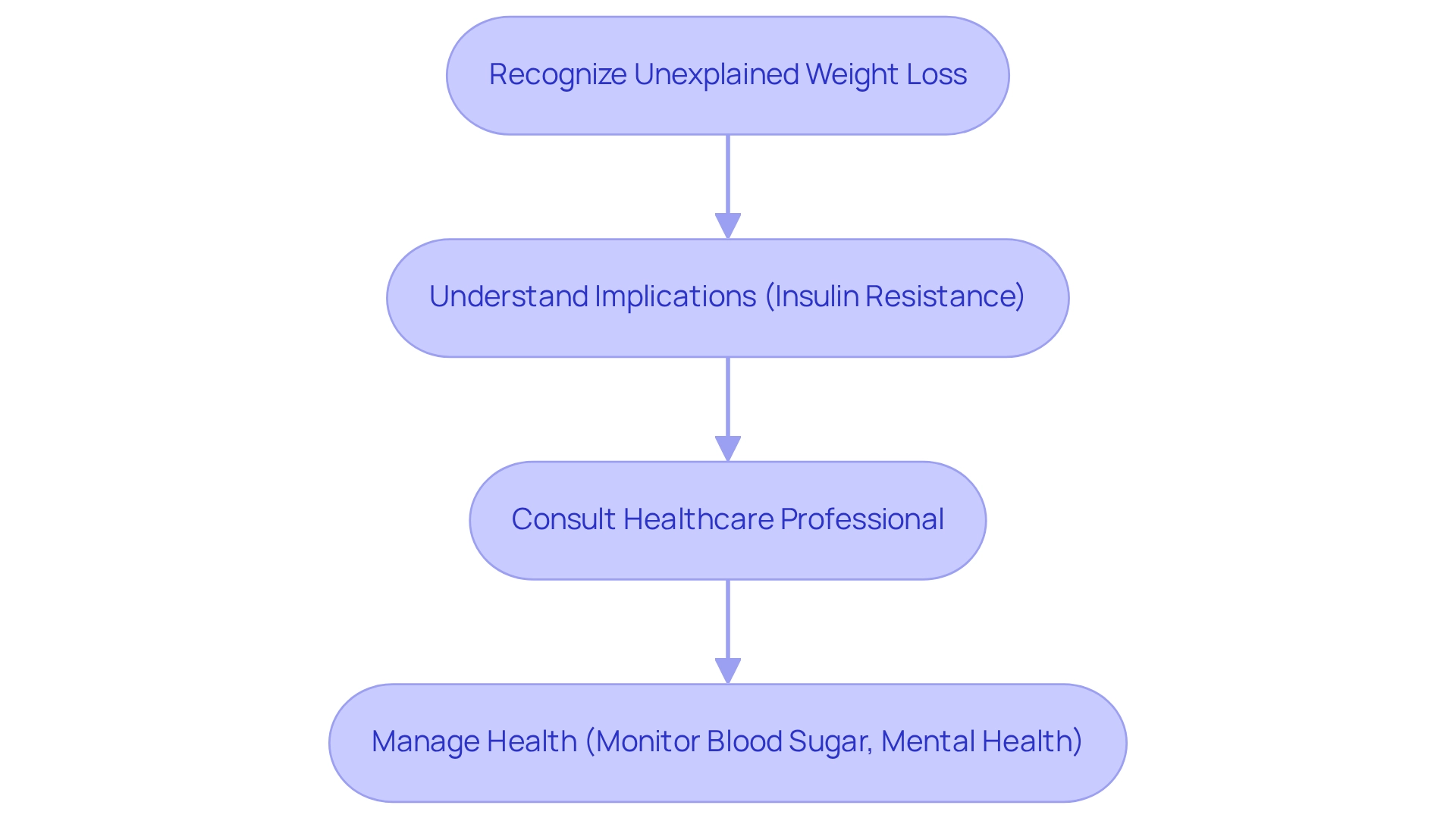
Blurred Vision: An Important Early Symptom of Type 2 Diabetes
Distorted sight serves as a crucial initial warning indicator of type 2 diabetes signs. Elevated blood sugar levels can lead to swelling in the lens of the eye, resulting in temporary vision changes. It's concerning that around 25% of individuals recently diagnosed with the second form of the condition report experiencing vision disturbances, which are among the type 2 diabetes signs, highlighting the prevalence of this symptom (American Diabetes Association). If you experience persistent blurred vision, it’s essential to seek medical consultation immediately, as it may indicate type 2 diabetes signs associated with uncontrolled blood sugar levels that require intervention.
At T2DSolutions, we understand how vital it is to manage blood sugar effectively to reduce the risk of vision complications. Ophthalmologists emphasize the importance of routine eye assessments for individuals at risk, noting that prompt detection and treatment can significantly improve outcomes. For instance, a case study revealed that a patient suffering from blurred vision was diagnosed with a form of diabetes, leading to timely treatment that preserved their eyesight.
Moreover, an early diagnosis of Type 2 condition can help slow its progression and prevent complications, reinforcing the need for awareness of symptoms like blurred vision. Community support is invaluable in navigating these challenges. Sharing experiences about symptoms such as blurred vision fosters resilience among individuals coping with the condition. T2DSolutions aims to provide a platform for such engagement, as illustrated in the case study titled 'Community Support in Managing Diabetes,' which shows how community participation can lead to improved health outcomes. By recognizing the connection between high blood sugar and vision changes, patients can take proactive steps towards better health management. As the American Diabetes Association states, "Despite its complications, individuals can manage their health issue with a comprehensive plan that includes lifestyle changes and proper medical care.

Fatigue: A Subtle Early Sign of Type 2 Diabetes
Fatigue often emerges as a subtle yet significant initial sign of type 2 diabetes signs, which is frequently overlooked by many. When the body struggles to effectively utilize glucose for energy, it can lead to persistent tiredness, even after a full night's sleep. This fatigue is not simply a result of lifestyle factors; it can be a crucial indicator of underlying metabolic issues. Studies reveal that around 70% of individuals diagnosed with Type 2 Diabetes report experiencing type 2 diabetes signs, such as fatigue, prior to their diagnosis, highlighting its commonality as an early symptom.
Healthcare providers stress the importance of recognizing fatigue as a potential warning sign of type 2 diabetes signs. Dr. Jane Smith, an endocrinologist, shares, "When energy levels are consistently low, it may warrant further investigation into glucose metabolism and overall health." Indeed, research indicates that timely diagnosis of type 2 diabetes signs can significantly slow the progression of the condition and prevent complications. Therefore, it is essential for individuals to discuss any unusual fatigue with their healthcare provider.
Real-world experiences illustrate this connection: many patients have recounted feeling unusually tired as one of the type 2 diabetes signs before receiving their diagnosis. One patient expressed, "I felt exhausted all the time, even after sleeping well. It wasn't until I was diagnosed that I realized it was a sign of something more serious." These narratives emphasize the need for awareness of the type 2 diabetes signs and proactive health management. Furthermore, ongoing research continues to explore the relationship between fatigue and blood sugar symptoms, reinforcing the idea that fatigue is not just a common complaint but a potential early warning sign of type 2 diabetes signs.
Incorporating community support can also enhance awareness and understanding of these symptoms. T2DSolutions highlights the importance of sharing experiences, as connecting with others can foster resilience and hope in managing the condition. As Tiffany Danczak wisely stated, "Don’t let yourself fall, you gotta pick yourself right up and strive to do better and be better!" By acknowledging fatigue as a key indicator, individuals can take proactive steps toward better health outcomes. For additional details and support regarding the management of the condition, visit T2DSolutions, your comprehensive resource for Type 2 Diabetes education.
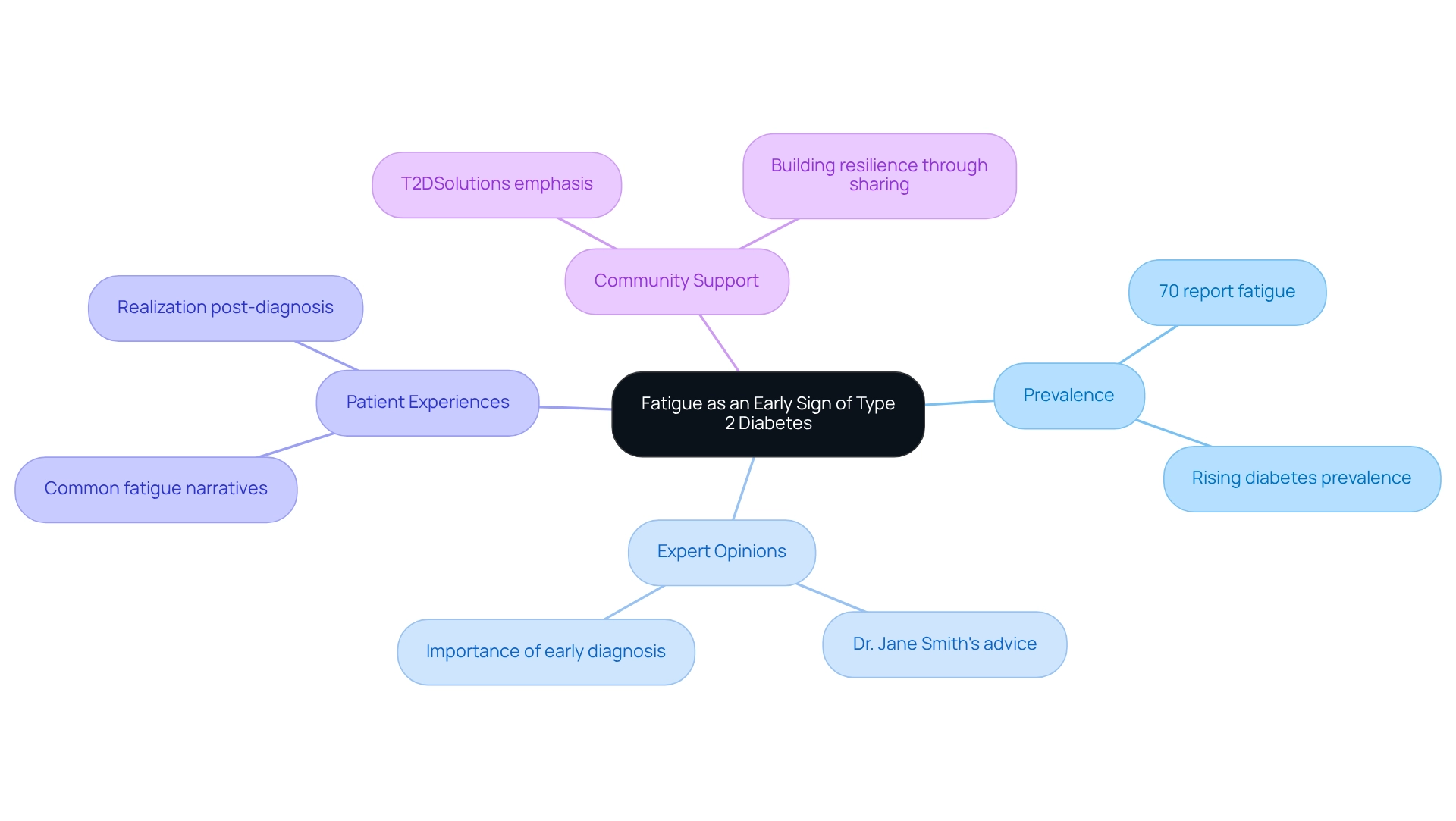
Slow-Healing Sores: A Warning Sign of Type 2 Diabetes
Slow-healing sores can be critical warning signs of type 2 diabetes, and it's important to pay attention to them. Elevated blood sugar levels may damage blood vessels and nerves, significantly affecting circulation and the body's natural healing processes. Research shows that individuals with high blood sugar are more likely to experience delayed wound healing, with studies indicating that nearly 50% of affected patients face slow-healing sores.
Recognizing type 2 diabetes signs early is vital, as they impact a significant portion of the diabetic population. For example, a recent case study on hyperbaric oxygen therapy for diabetic foot ulcers revealed that this treatment could enhance healing outcomes. While the precise mechanisms are still being explored, it offers hope.
Furthermore, psychological interventions have been found to alleviate anxiety and depression in patients with diabetic foot ulcers. By addressing the emotional challenges tied to managing chronic wounds, these interventions can significantly improve patients' overall healing experience, particularly when type 2 diabetes signs are present. It is crucial to consult a healthcare professional if cuts or sores are taking longer to heal than usual. Early intervention can lead to better management of blood sugar issues and help prevent complications.
You're not alone in this journey; specialists emphasize that identifying these indicators promptly can greatly influence treatment outcomes. Recent findings also suggest that autologous stem cell treatment may result in lower amputation rates and improved wound healing, highlighting the advancements in diabetes care. Remember, we are here to support you every step of the way.
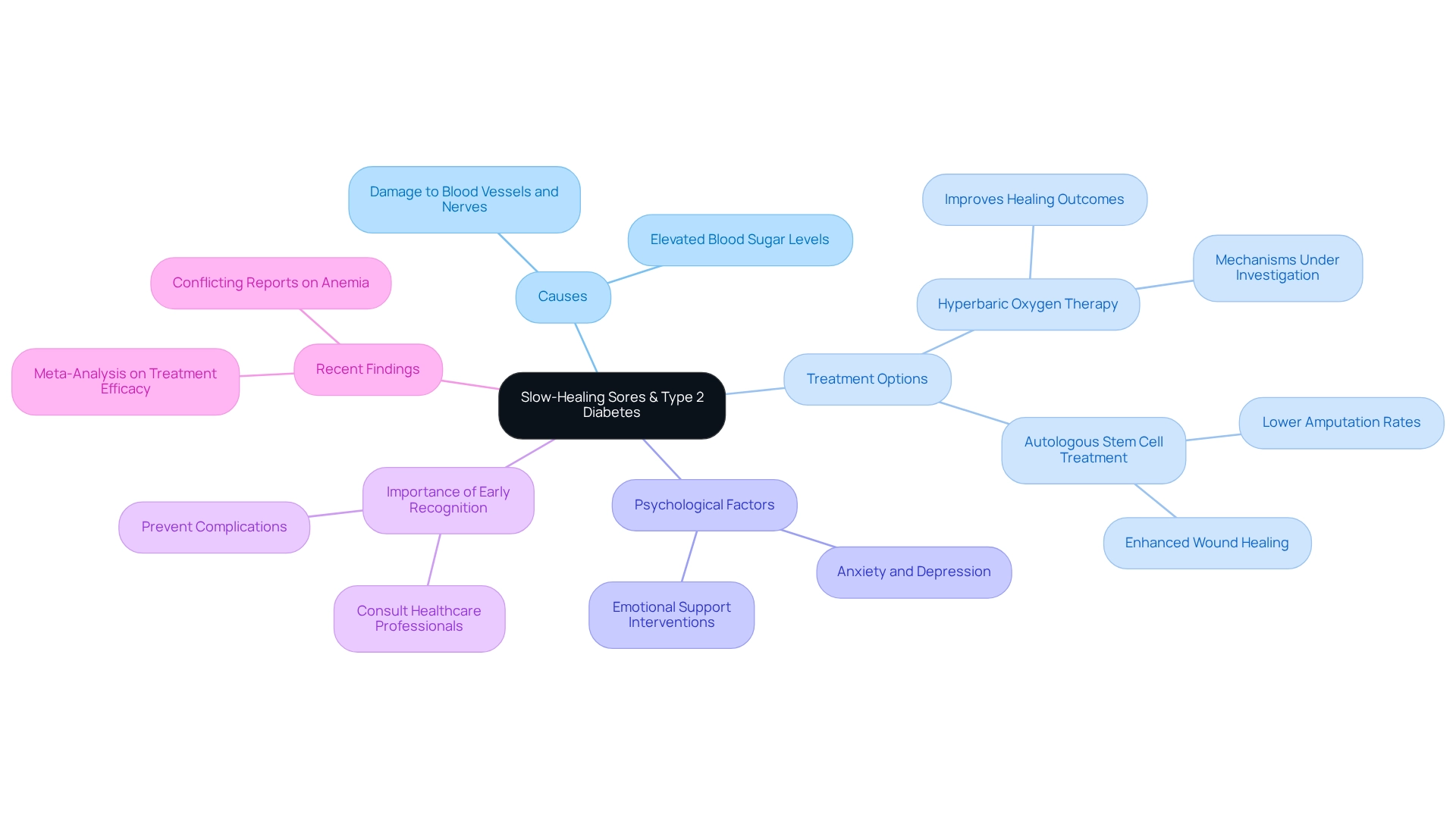
Frequent Infections: An Early Indicator of Type 2 Diabetes
Repeated infections can serve as an important initial sign of a high blood sugar condition. When blood sugar levels are elevated, the immune system can be compromised, making it increasingly challenging for the body to effectively combat infections. Research shows that individuals with Type 2 Diabetes often face a higher prevalence of recurrent infections, especially urinary tract infections and skin infections. For instance, a study that examined the clinico-microbiological profile of urinary tract infections in patients with high blood sugar provided valuable insights into the types and frequency of these infections, highlighting the urgent need for personalized management strategies.
Statistics reveal that those newly diagnosed with high blood sugar are particularly susceptible to recurrent infections. This underscores the importance of prompt detection and management. If you notice a pattern of recurrent infections, it’s crucial to reach out to a healthcare professional. These infections may not only signal an underlying issue but also indicate type 2 diabetes signs, stressing the need for proactive management of blood sugar. Experts emphasize that addressing these early warning signs can lead to improved health outcomes. Remember, you're not alone in this journey; shared knowledge and support are vital in managing your condition effectively.
At T2DSolutions, we understand the importance of education in managing this illness. We encourage patients to explore our resources to gain a better understanding of the implications of frequent infections and how to manage them. Additionally, it's essential to remind patients about the value of routine immunizations, such as COVID-19, influenza, and pneumonia vaccines, which can significantly reduce the risk of serious infections and associated mortality rates. Pharmacists are also in a unique position to provide education on managing blood sugar levels, which can enhance clinical outcomes and diminish infection complications. By recognizing the link between frequent infections and blood sugar issues, individuals can take informed steps toward better health. We are here to support you every step of the way.
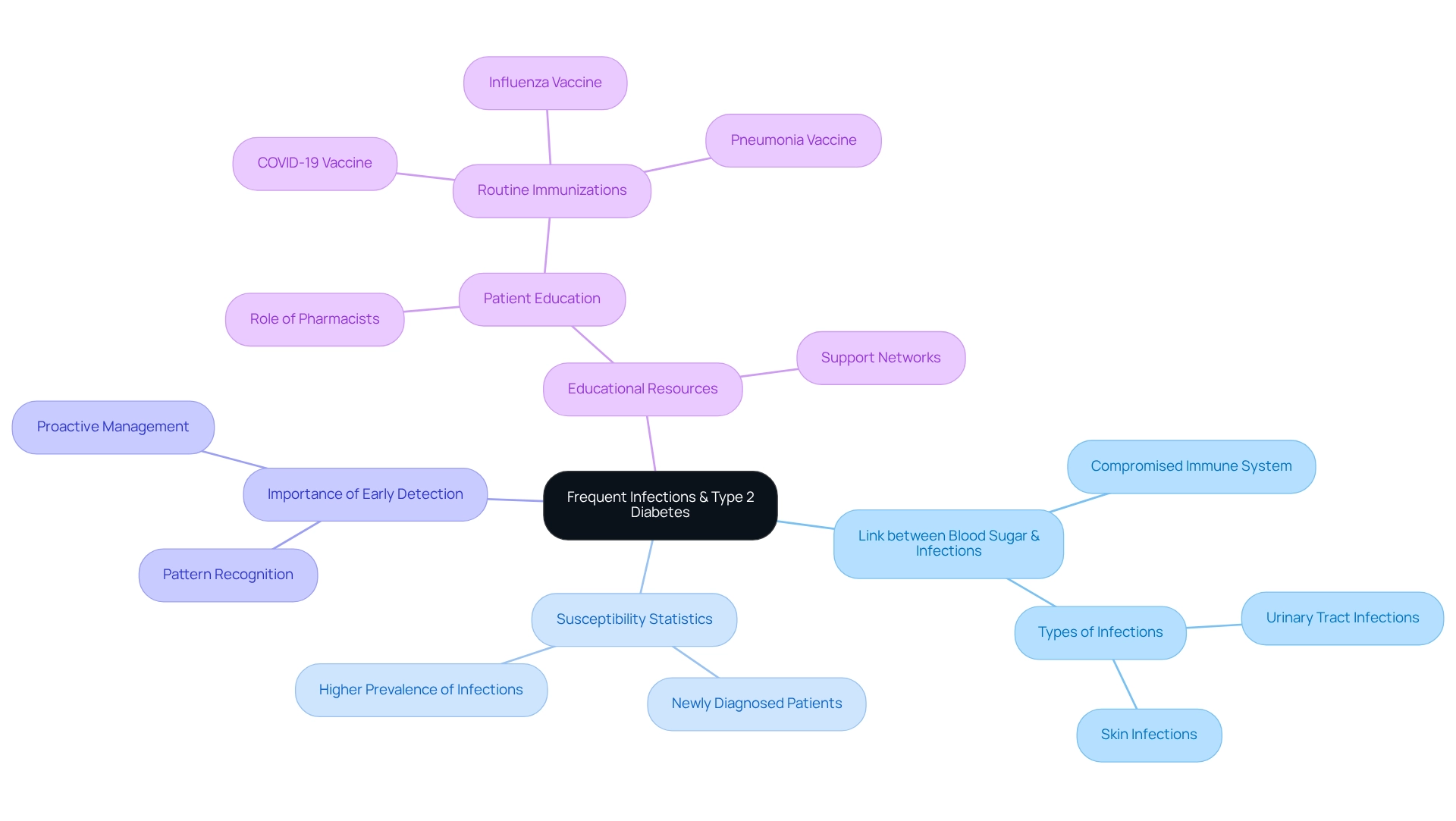
Dark Skin Patches: A Visual Early Sign of Type 2 Diabetes
Dark skin patches, often seen in areas like the neck, armpits, and groin, can be an important early visual sign of type 2 diabetes signs. This condition, known as acanthosis nigricans, is closely linked to insulin resistance, which is a key indicator of glucose intolerance. It's understandable to feel concerned—recent studies show that at least 50% of adults who weigh double their ideal body weight exhibit signs of this skin condition. This highlights its prevalence among those at risk for diabetes, as acanthosis nigricans is one of the type 2 diabetes signs; dermatologists want you to know that it’s not just a cosmetic issue, but a treatable condition that can indicate underlying metabolic problems. If you notice these changes in your skin, reaching out to a healthcare provider for further assessment is crucial. Prompt intervention can lead to better management of your health.
At T2DSolutions, we are here to support you every step of the way, offering resources and assistance for individuals facing the challenges of Type 2 Diabetes. Remember, you’re not alone in this journey, and there are people ready to help you navigate through it.
Recognizing Early Signs: Importance of Seeking Medical Advice for Type 2 Diabetes
Identifying the type 2 diabetes signs is essential for effective management and the prevention of complications. Symptoms such as increased thirst, frequent urination, fatigue, and blurred vision are often type 2 diabetes signs that should not be overlooked. It's understandable to feel overwhelmed by these symptoms, but seeking prompt medical advice can significantly enhance your management strategies and lead to improved health outcomes. Did you know that 8.0% of U.S. adults with diagnosed diabetes have a non-HDL cholesterol level of 190 mg/dL or higher? This statistic highlights the importance of timely intervention in preventing cardiovascular complications that can arise from unmanaged diabetes.
Practical examples illustrate that prompt diagnosis can dramatically enhance diabetes management. For instance, a program implemented by the Public Health Agency of Canada between 2000 and 2013 aimed to reimburse insulin prescriptions for registered First Nations individuals. This initiative not only improved access to necessary medications but also enhanced overall health outcomes within these communities, showing the positive impact of timely medical intervention.
Experts emphasize that prompt medical advice is crucial. Diabetes experts observe that identifying type 2 diabetes signs early can lead to timely interventions, which are essential for effective management. Furthermore, it's important to recognize that individuals with blood sugar issues are twice as likely to experience depression compared to those without. This highlights the need for comprehensive care that addresses both physical and mental health. Early diagnosis and management can help mitigate this risk by ensuring that you receive the support you need promptly.
Incorporating early diagnosis into your management strategies can yield significant benefits. Research indicates that 28 percent of healthcare expenses linked to diabetes are associated with nervous system disorders. By seeking medical advice at the first signs of diabetes, you can potentially reduce these costs through proactive healthcare measures. Remember, taking control of your health can lead to an improved quality of life. You're not alone in this journey; we are here to support you every step of the way.
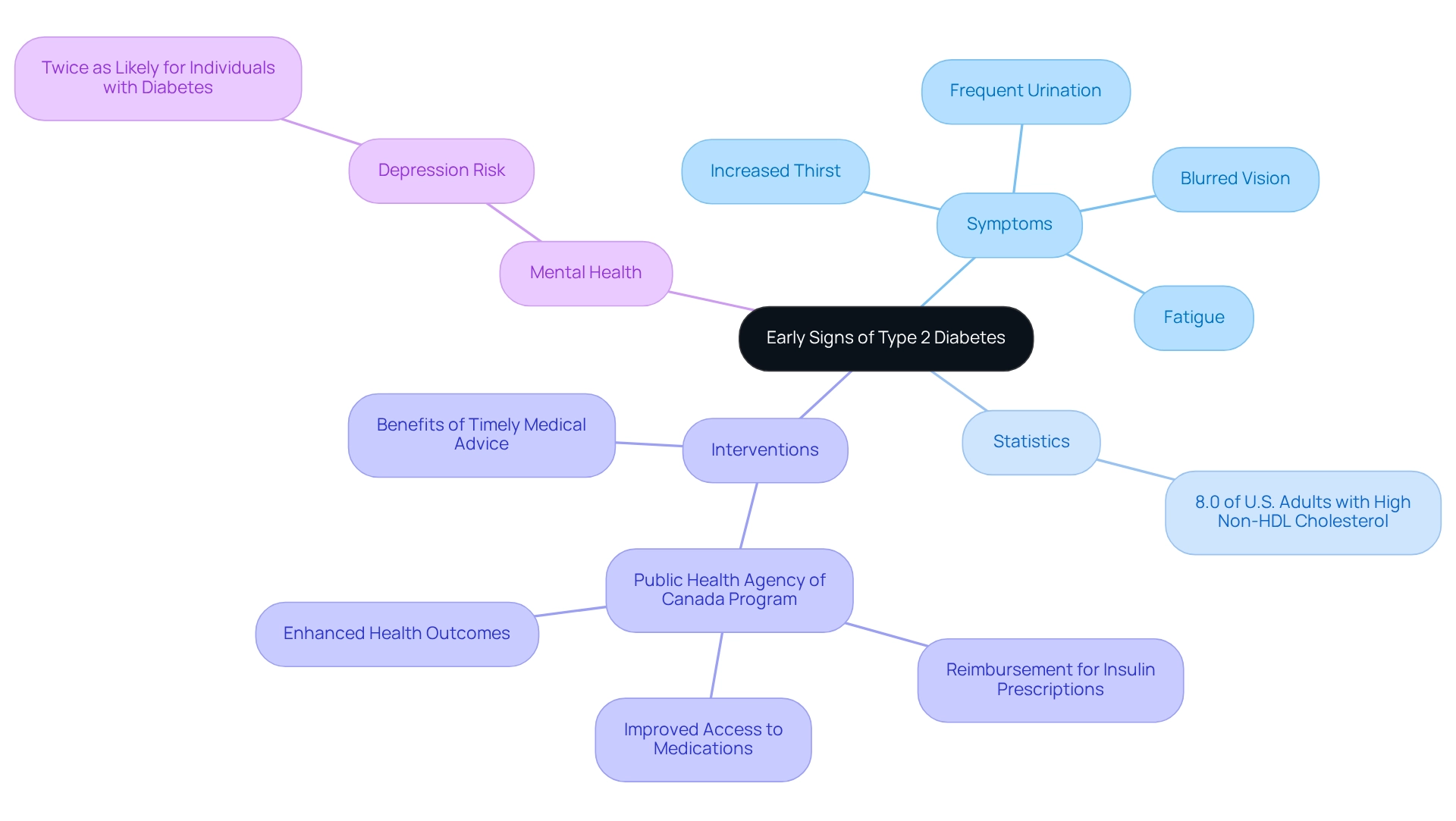
Conclusion
Recognizing the early signs of Type 2 Diabetes is not just beneficial; it is essential for effective management and prevention of serious complications. Symptoms such as increased thirst, frequent urination, unexplained weight loss, blurred vision, fatigue, slow-healing sores, frequent infections, and dark skin patches serve as critical indicators that should not be overlooked. By understanding these warning signs and seeking prompt medical advice, you can significantly enhance your management strategies and improve your overall health outcomes.
The importance of early detection cannot be overstated. Research indicates that timely intervention can lead to better management and reduced risk of complications. Awareness is a powerful tool in the fight against diabetes, and T2DSolutions stands out as a vital resource. They provide educational materials and a supportive community to empower you in recognizing these symptoms and taking proactive steps towards your health.
Ultimately, fostering a culture of awareness and education around Type 2 Diabetes is crucial. By sharing experiences and supporting one another, you can navigate the complexities of diabetes management more effectively. T2DSolutions not only equips you with knowledge but also encourages a collective journey towards better health. Remember, early recognition and intervention can pave the way for a healthier, more fulfilling life. You're not alone in this journey; we are here to support you every step of the way.
Frequently Asked Questions
What is the purpose of T2DSolutions?
T2DSolutions aims to empower individuals with knowledge about the signs of type 2 diabetes, providing educational materials and community support for effective blood sugar management.
Why is early detection of type 2 diabetes important?
Early detection is crucial as it can significantly enhance management strategies and reduce the risk of complications, improving health outcomes.
What are some common signs of type 2 diabetes?
Common signs include heightened thirst (polydipsia), frequent urination (polyuria), fatigue, blurred vision, and slow-healing wounds.
How does polydipsia relate to type 2 diabetes?
Polydipsia, or heightened thirst, is often one of the first signs of type 2 diabetes and occurs due to dehydration from elevated blood sugar levels.
What percentage of newly diagnosed patients report experiencing polydipsia?
Research indicates that nearly 50% of newly diagnosed patients report experiencing polydipsia.
What is polyuria and how is it connected to type 2 diabetes?
Polyuria, or frequent urination, occurs when the kidneys filter excess glucose due to high blood sugar levels, leading to increased urine production.
What percentage of individuals report polyuria at diagnosis?
Approximately 30% of individuals newly diagnosed with type 2 diabetes report experiencing polyuria.
How can dietary management help with symptoms of type 2 diabetes?
Effective dietary strategies, such as adopting a Mediterranean or plant-based diet, can help manage blood sugar levels, alleviate symptoms like polydipsia, and improve overall hydration.
What role does T2DSolutions play in supporting individuals with diabetes?
T2DSolutions provides resources, practical tips, expert insights, and community support to help individuals manage their diabetes effectively and make informed health decisions.
What should individuals do if they experience symptoms of type 2 diabetes?
Individuals experiencing symptoms such as increased thirst or frequent urination should consult a healthcare provider for timely evaluation and potential diagnosis.



